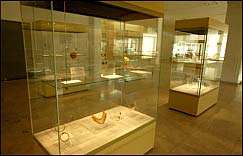The Islamic Arts Museum Malaysia (IAMM)
Part 3TEXTILE GALLERY
Overall view of Textile GalleryThe Textile gallery displays a wide collection of different types of textiles from the Islamic world between the 16th to 20th century. These include robes, coats and costumes, shawls, runners, hangings, panels, headdresses and more. The different techniques of production and decorative styles are given emphasis and the pieces are grouped according to their provenance or style. Woven, printed and embroidered textile and clothing production has had a considerable history in the Islamic world with many techniques and styles dating back to pre-Islamic times. Islamic textiles can be recognized for their intricate patterns, symmetrical designs and balanced compositions. In Islamic culture, there is an emphasis on the inner section of the textile as well as the outer, stressing the Islamic teachings of purity of inner self than that which is viewed externally.
Embroidered satin mosque portiereSyria or Turkey; 19th century ADA pair of boots;Ottoman Empire19th century ADEmbroidered prayer hangingIndo- Iran. c. 1800 ADJEWELLERY GALLERY
The Jewellery gallery features fine examples of Islamic jewellery in the different techniques of; gem-setting, enamelling, filigree working and gilding. The jewelleries are displayed categorically to indicate their place of origin, the innovation of Islamic ornamentation and the richness of the materials used. Most of the artefacts on display originate from various countries found throughout the Islamic world such as;India, Iran, Syria, Egypt, Turkmenistan and the Malay Archipelago. The Indian jewellery collection on display includes elaborate pieces of necklaces, turban ornaments and armbands from the Mughal dynasty employing the use of cabochon emeralds, rubies and table cut diamonds, set in gold in a technique known as kundan. The collection of Iranian earrings, which were produced between the 11th to 19th centuries are equally impressive. A distinctive feature of Qajar dynasty jewellery is the vividly coloured enameled motifs and settings of highly coloured stones. Tribal jewellry from Turkmenistan comprises a significant part of the collection. Set with agate and coral, with chased or repoussé surfaces, they are illustrative of folk jewellry in both the relatively simple construction and high symbolism in motif and design.

The Arms and Armour gallery is one of the 11 permanent galleries in the Islamic Arts Museum Malaysia. The gallery is devoted to the weapons and protective garments of medieval Islamic societies and highlights a varied range of weaponry from the Islamic world each defined by its form, material and decorative style. From symbols of office to daily utilitarian utensils to mechanisms of battle, arms and armour in the Islamic world were often embellished on lavish material to create spectacular works of art. The Gallery features a collection of swords, daggers, spears, maces, axes, firearms, body armour and shields, which date between the 11th - 19th century, originating from various Islamic regions such as Saudi Arabia, Iran, Turkey, India and North Africa.
View of the Arms & Armour GalleryLinen talismanic tunicTurkey. 16th century ADJade hilted dagger;Iran. c. 1800 AD
Gold damascened vambraceIran. C. 1741-2 AD